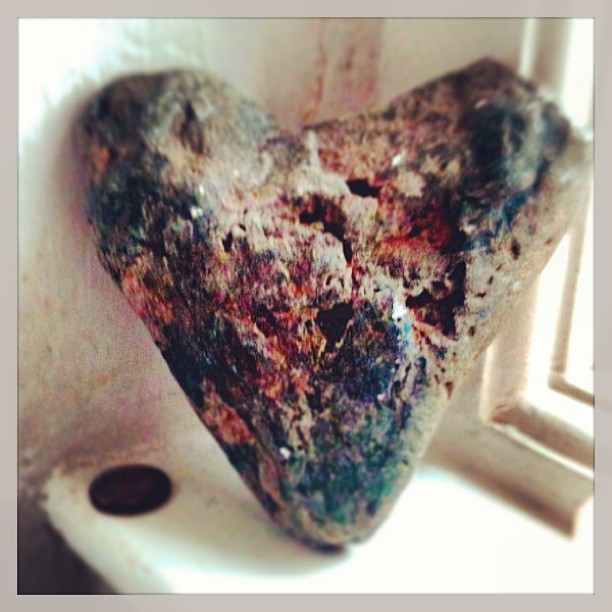Centring, Opening and Cleansing the Heart Chakra
The heart chakra is an energy centre, the most powerful of all the seven chakras, when we are closed in the heart, we are cutting ourselves off from the rich and everlasting peace, love and harmony that emanates from the universe.
The heart holds Samskaras, from this and previous lives that influence the way we behave, think and react to certain triggers in this life. These Samskaras can be cleared and released to give us more freedom and mental clarity through the practice of yoga.
A Samskara maybe created through a traumatic experience such as a lover betraying you, the death of a parent or child, losing money, health problems, there are many ways that these impressions can be created. There can also be positive Samskaras, from feeling great love, being blessed with a child, a happy marriage, abundance or good health.
What are Samskaras?
Samskaras are impressions left on the heart chakra from past Karmic experiences. We all have them, without them we would not be human, they are natural. Just as a garden always has weeds, the weeds will always come and we will want to uproot them. So we can uproot our Samskras through yoga, a union of body, mind and spirit. It would never be possible to rid ourselves of all Samskaras but we can work with the ones that challenge us most, the ones that keep forming and manifesting into our lives. e.g. if you had a Samskara held from a previous experience where you had been betrayed by a lover, you may keep attracting a similar experience to you so that you can eventually release and heal the blockage in your heart chakra. This can be painful but in the long run it will help you to move more freely through your soul journey.
The memory of why we have a particular Samskara may now be gone, if it has affected us from a past life we would not know the cause. But the impression on our heart is still there.
Samskaras are a part of the cycle of Karma:
> Action (Karma) > Impression (Samskara) > Tendency (Vasana) > Thought pattern ( Vritti) > Action (Karma)>
A Vasana is the effect of a Samskara. These are tendencies, or inclinations that are identifiable as our instinctive and emotional urges, desires and feelings, whether they be negative or positive.
Vritti are the thought patterns that are created by the Vasana. Our thinking pattens (Vritti) are motivated by our tendencies (Vasana), we think to support our feelings. These Vritti form our patterns, our attitudes and our mental disposition.
Finally our Vritties lead us into action (Karma). We act out Karma because our mind tell us through our Vritti to act, because that is how we will satisfy our desire (Vasana) which arose from an impression (Samskara) made in the mind from an earlier memory of an action.
So using the example of having a Samskara impression on the heart caused by a previous betrayal:
The wound wound would create a Vasana, an urge or desire to feel jealousy if our partner is close to another in any way, this Vasana would then create Vritti, thought patterns that make us think terrible things, negative thoughts of jealousy, letting the imagination run riot thinking of what could be going on between them, this could then lead to us acting out our Karma by reacting to our partner or the other person negatively. We could have an argument, push them away, get scared and behave badly in some way, end the relationship or seriously damage it, thus creating more Karma with that person and more Samsakara wound in our heart
We have many of the Karmic cycles continuing throughout our lives. According to Patanjali author of the yoga sutras we must complete 36,000 cycles of creation before we can be released into Moksha, release from the cycle of Karma.
Can we control our Samskaras?
We can not control our past Samskaras because they have been created as a result of our actions, but perhaps we can stop our past Samskaras from controlling us.
The answer is in the practice of yoga which can help us to break the Karmic cycle at the Vritti level, so interrupting the thought patterns that cause us to act in particular ways, thus giving us new Karma and creating new Samskaras or adding to those we already have.
Patanjali defines yoga as this:
*Yoga is the restriction (control) of the fluctuations of consciousness*. So we must try to control our Chittavritti (the monkey mind/mind chatter) the various thoughts of the mind.
Patanjali explains there are 5 types of thoughts in the mind, some painful others painless:
1) thoughts about truth
2) thoughts based on incorrect perception
3) thoughts which have no basis in reality (day dreaming, verbal delusion, talking to oneself in ones mind or vocally and making no sense, having no basis in fact and uncontrolled imagination)
4) dream sleep state of mid
5) memories
By practising the 8 Limbs of Yoga we can attain the highest state of consciousness and be freed from ignorance and egocentricity, which are the cause of ones pain and suffering. One gains complete mastery of the mind and is absolutely no longer controlled by ones Samskaras.
1) Yamas: non violence, truthfulness, non stealing, self restraint, non covetousness
2) Niyamas: cleanliness, contentment, discipline,study, surrender to God
3) Asanas: yoga postures
4) Pranayama: breathing control
5) Pratyahara: sensory withdrawal
6) Dharana: concentration
7) Dhyana: meditation
8) Samdhi: state of ecstasy
By controlling the mind through yoga we can begin to control our Samskaras and release ourselves from cycles of Karma. When we feel the effect of a Samskara we can sit still, meditate and release the energy through our heart centres, this can feel uncomfortable and it is common for us to wish to distract ourselves from this pain. But by allowing it to move through us we can release it once and for all. We need also to refrain from reacting in any way when we are feeling the effects of a Samskara, stay still, sit and move to a place of peace, then decide the best way to deal with a situation or what needs to be said to a person involved, this way we are releasing a Samskara and by staying positive and peaceful we are not creating another.
Forgiveness and Compassion
Firstly, when we begin to understand the cycle of Karma, we can start to forgive ourselves. The cycle of Karma is universal, Divinely guided and destined by God alone. Our Karma is beyond powerful and beyond anything we can control, therefore we can find humility in knowing that our patterns and our behaviours are being caused by blocks in this Karma and not just by our own mistakes and weaknesses in this lifetime.
Forgive yourself and move instead to looking deeply at how to heal your Samskara blocks through the practice of yoga, choose to put time and effort into working at the Vritti level to be more aware and mindful of your thoughts, rather than spending time feeling guilty for your mistakes.
To help us clear the heart chakra further we can bring forgiveness and compassion where it is needed.
A vital part of cleansing the heart chakra is to forgive, this is a beautiful prayer that we will be working with:
Adding the name of the person you wish to work with to the blanks, repeat the first and second part out loud or in your mind for 3 minutes each, then lay down with your hands on your heart and repeat the third for 3 minutes:
1) I forgive ……. for all he/she has done to upset me.
2) I ask and I receive forgiveness for all I have to done to upset ……
3) I forgive myself, I dwell in Light, I dwell in Love.
Repeat daily to instil a sense of peace and compassion in your situation
(Forgiving others is not to allow ourselves to be mistreated. Forgiveness can take time and often there is a process to go through before the point of forgiveness is reached. Acknowledgement of hurt or damage to yourself or others, processing of healthy anger and shadow work, placing of boundaries to ensure we are protecting from others mistreatment of us, work to being self-empowerment to ensure we are acting in healthy ways and surrounding ourselves with kind, empathic people. Forgiveness can not and should not be rushed or forced as it can take away from these vitals stages of healing. Compassion in life is vital, but self compassion comes first)
A chant/mantra of self healing, humility, relaxation, protective grace, ecstatic joy and emotional relief.
Guru Guru Wahe Guru, projects the mind to the Infinite, the source of knowledge and ecstasy.
Guru Ram Das Guru means, the wisdom that comes as a servant of the Infinite this brings us guidance.
Guru Guru Wahe Guru Guru Ram Das Guru
Listen to this beautiful healing chant on youtube xx
First written by Saira in November 2014


